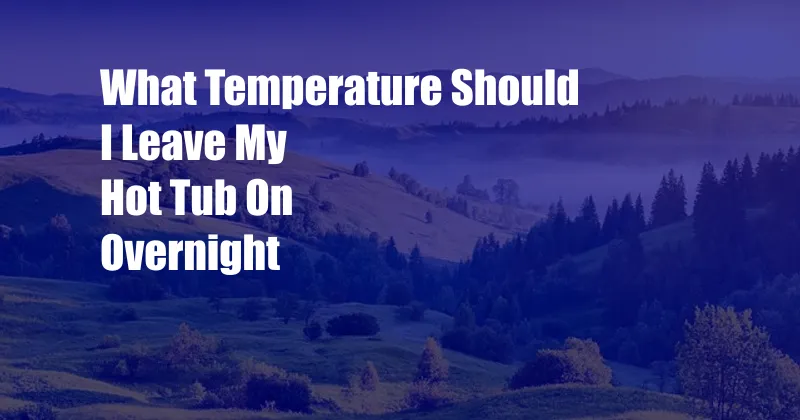
What Temperature Should I Leave My Hot Tub on Overnight?
As a hot tub enthusiast, I understand the comfort and relaxation they provide after a long day. However, to ensure optimal enjoyment and energy efficiency, it’s crucial to determine the ideal temperature setting for overnight use. In this comprehensive guide, I’ll delve into the factors to consider and provide expert tips for setting the perfect temperature for your hot tub, ensuring a comfortable and energy-conscious soak.
Before we dive into the specifics, it’s important to set the stage with some background information. Hot tubs, also known as spas or whirlpools, have gained immense popularity over the years as a means of relaxation, stress relief, and hydrotherapy. They work by circulating heated water through jets, creating a soothing and therapeutic experience.
Choosing the Ideal Overnight Temperature
The ideal overnight temperature for your hot tub depends on several factors, including:
- Personal preference: Some individuals prefer warmer temperatures, while others enjoy cooler soaks. Determine your comfort level and adjust the temperature accordingly.
- Energy efficiency: Maintaining a lower temperature overnight can save energy compared to higher settings.
- Tub insulation: Well-insulated hot tubs retain heat better, allowing you to lower the temperature overnight without significant heat loss.
- Outdoor temperature: During colder months, it may be necessary to increase the temperature overnight to prevent freezing.
With these factors in mind, let’s explore the recommended temperature ranges for overnight use:
- Standard overnight temperature: For most hot tubs, a temperature between 80-85°F (27-29°C) is a good starting point. This range provides a comfortable soak without excessive energy consumption.
- Cooler overnight temperature: If you prefer a cooler soak or want to save energy, you can lower the temperature to around 75-80°F (24-27°C).
- Warmer overnight temperature: During colder months or for individuals who prefer warmer soaks, the temperature can be raised to 85-90°F (29-32°C).
Tips for Energy-Efficient Overnight Use
In addition to setting the ideal temperature, there are several tips you can follow to minimize energy consumption overnight:
- Use a thermal cover: A well-fitting thermal cover helps retain heat, reducing the need for constant heating.
- Lower the temperature by a few degrees: Even a small temperature reduction can save energy over time.
- Consider a timer: Many hot tubs have built-in timers that allow you to automatically lower the temperature overnight.
- Insulate your hot tub: Adequate insulation around the hot tub helps prevent heat loss, especially in colder climates.
- Use a heat pump: Heat pumps are more energy-efficient than traditional heating systems, providing a cost-effective way to maintain the desired temperature.
By implementing these tips, you can enjoy a comfortable and energy-conscious hot tub experience overnight without sacrificing relaxation or comfort.
Frequently Asked Questions about Overnight Hot Tub Temperatures
- Q: What happens if I leave my hot tub on too high overnight?
A: Leaving your hot tub on at an excessively high temperature can increase energy consumption, damage the equipment, and shorten the lifespan of your hot tub. - Q: Can I use my hot tub overnight even if it’s below freezing outside?
A: If your hot tub is properly insulated and has a freeze protection feature, it can be used overnight even in freezing temperatures. However, it’s important to ensure the water does not freeze, as this can damage the plumbing and equipment. - Q: How often should I change the water in my hot tub?
A: The frequency of water changes depends on usage and water chemistry. Generally, it’s recommended to change the water every 3-4 months or more often if the tub is used frequently.
Conclusion
Determining the ideal overnight temperature for your hot tub is essential for a comfortable and energy-efficient experience. By considering the factors discussed above and following the expert tips provided, you can optimize your hot tub’s performance and enjoy a relaxing soak without compromising energy consumption. Whether you prefer warmer or cooler temperatures, finding the right balance is key to maximizing your hot tub’s benefits.
Are you interested in learning more about hot tub maintenance, energy efficiency, or other related topics? Leave a comment below or browse our other articles for more informative and engaging content. Together, let’s enhance your hot tub experience and create a relaxing and rejuvenating outdoor oasis for you and your loved ones.